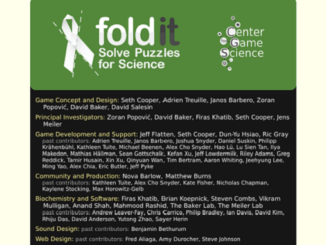
Can You Diagnose Dementia from a Gaming App?
By Bahar Gholipour on November 18, 2016
SAN DIEGO—You are guiding a ship through rough waters. On your way you may encounter magical creatures. You can snap a photo or two, but your main job is to navigate the maze of waterways to find missing pieces of a long-lost journal. You might get lost occasionally, but that’s all right. After all, this is just a mobile game and the scientists behind it are tracking your performance to measure how people of all ages compare in their spatial navigation abilities.
The ultimate goal is to use this data to spot navigation problems early on in millions of people afflicted with dementia, hoping this might lead to better tests for the devastating illness. “By creating a global chart of human spatial navigation, we’d like to create the next set of tools for the diagnosis of Alzheimer’s,” says neuroscientist Hugo Spiers of University College London, one of the scientists behind the mobile app game Sea Hero Quest.[…]
Reverse the Odds, analyze real cancer data by playing a mobile game
By Larry Greenemeier on March 3, 2015
In recent years, many scientists have turned to crowdsourcing as a way to outsource some of the more tedious aspects of their research. To make the work less monotonous for laypeople, they often develop games to distract citizen scientists from mind-numbing reams of data large amounts of data. Cancer Research U.K. has done this with its Play to Cure: Genes in Space and Cell Slider games. Their latest is Reverse The Odds, which encourages citizen scientists to help a group of colorful creatures known as the “Odds,” whose world is falling into decline. By completing mini puzzle games and upgrading their land, volunteers can restore the Odds back to their lively selves.[…]
Online Gamers Help Crack Mystery of How Eyes Sense Motion
By Mo Costandi, Nature magazine on May 5, 2014
Citizen-science volunteers helped to trace a map of the neural connections involved in detecting the direction of moving objects,
To understand how bipolar and starburst cells are wired together, Kim and his colleagues analyzed high-resolution electron microscope images of a mouse retina with the help of nearly 2,200 members of EyeWire, an online ‘citizen-science’ game set up to help with brain-mapping efforts (see ‘Computer science: The learning machines’). Players traced the pathways through the layers of cells to create a high-resolution wiring diagram of part of the retina.[…]
EteRNA, Game lets citizen scientists participate in creating large-scale library of synthetic RNA designs
By Larry Greenemeier on March 11, 2014
By playing EteRNA, citizen scientists participate in creating the first large-scale library of synthetic RNA designs. Your efforts help reveal new principles for designing RNA-based switches and nanomachines–new systems for seeking and eventually controlling living cells and disease-causing viruses. By interacting with thousands of players and learning from real experimental feedback, you will be pioneering a completely new way to do science.[…]
Forgotten Island, contribute to scientific knowledge while playing this adventure game
March 4, 2014
Forgotten Island is a citizen science project disguised as an adventure game. The premise is this: A mysterious explosion has destroyed the island’s biology lab and scattered living specimens across the strange landscape. Now, a bombastic robot named DOC73R-CY3N53 is calling the shots, ordering you to re-classify his specimens and rebuild the island in his image. In this point-and-click game, citizen scientists can participate in scientific research while foraging through fearful forests, vicious volcanoes, desolate docks, and more.[…]
The Neuroscience Revolution Will Be Crowdsourced
By Ben Thomas on September 11, 2013
As Albert Einstein famously said, “No problem can be solved from the same level of consciousness that created it.”
The history of science is littered with so-called “intractable” problems that researchers later cracked wide open using techniques their ancestors could hardly imagine. Biologists in the 1950s looked at the staggeringly complex (and beautiful) three-dimensional shapes into which proteins fold and declared that a reliably predictive mathematical model of these convolutions might be unachievable in our lifetimes. But over the past few years, folks with home computers have joined forces to crack many longstanding protein-folding problems using the online game FoldIt.[…]
Last year, Seung’s lab rolled out a game called EyeWire. The principle is simple: After a few practice rounds, anyone with a computer and an Internet connection can help researchers map the shapes of actual neurons. In the game, these neurons come with their “skeletons” pre-drawn, and players take on the task of coloring in the neurons’ 3D shapes.[…]
Citizen Sort, a Web site with tools and games to classify various species of insects, animals and plants
October 23, 2012
The Citizen Sort Web site is designed to help biologists and ecologists with scientific classification tasks and to help information scientists and human-computer interaction researchers evaluate the role of motivation in citizen science. Citizen Sort needs the help of citizen scientists to classify species and aid the exploration of how motivation, citizen science and gaming all interact. […]
Foldit Gamers Solve Riddle of HIV Enzyme within 3 Weeks
By Michael J. Coren, Fast Company on September 20, 2011
The online game poses protein-folding puzzles, and participants provided insights recently that solved the structure of an enzyme involved in reproduction of HIV. When video gamers armed with the world’s most powerful supercomputers take on science and its most vexing riddles, who wins? Sometimes, it’s the gamers.
Humans retain an edge over computers when complex problems require intuition and leaps of insight rather than brute calculation. Savvy programmers and researchers at the University of Washington have tapped into this human “supercomputer” with Foldit, an online game that poses complex puzzles about how proteins fold, one of the hardest and most expensive problems in biology today. […]


